On October 16, 1859, John Brown launched a raid on Harpers Ferry, hoping to inspire a nationwide slave rebellion. He failed, but the Civil War broke out just 18 months later.
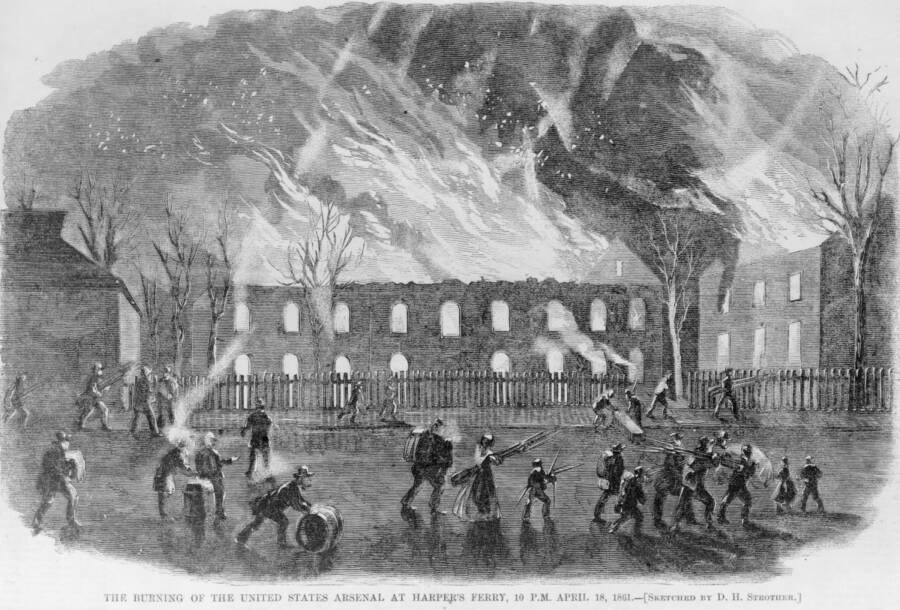
Library of CongressAn 1861 depiction of the burning of an arsenal during John Brown’s raid on Harpers Ferry.
There’s a famous Civil War marching song called Battle Hymn of the Republic that includes the line “John Brown’s body lies a-mouldering in the grave / His soul is marching on!” Just eighteen months earlier, John Brown — and his raid on Harpers Ferry — had helped incite the Civil War.
Though many Northerners viewed John Brown as a martyr, most Southerners had a different view. They saw Brown as a madman, a maniac. Brown remains a polarizing figure to this day, but historians have come to agree on the role the raid on Harpers Ferry played in American history.
It was not “simply a prelude to secession and civil war,” historian Tony Horwitz wrote in Midnight Rising: John Brown and the Raid That Sparked the Civil War. “In many ways, it was a dress rehearsal.”
The Man ‘Destined’ To End Slavery
Born on May 9, 1800, John Brown spent most of his life in obscurity. He tried his hand at multiple vocations, including being a farmer, a tanner, and a merchant, without any great success. But in 1837, HISTORY reports that Brown’s life changed after he attended an abolition meeting in Cleveland.

Public DomainJohn Brown, seen here in a circa 1846-1847 portrait, believed he was predestined to end slavery in the United States.
At that point, Brown — who was raised in a Calvinist and anti-slavery family — began to feel that he must act to end slavery in the United States. He spoke passionately about his desire to stamp out slavery at the 1837 meeting and came to believe that he was predestined to bring about its end.
From there, Brown started putting his words into action. In the 1850s, he and five of his sons traveled to Kansas, where pro- and anti-slavery factions had devolved into violence. Brown’s stated goal, according to Smithsonian Magazine, was “to help defeat Satan and his legions.”
After pro-slavery forces attacked the abolitionist town of Lawrence, Brown and his sons struck back at Pottawatomie Creek, killing five pro-slavery settlers with broad swords in the “Pottawatomie Massacre.” The bloodshed horrified many, including radical abolitionists. But Brown had no regrets.
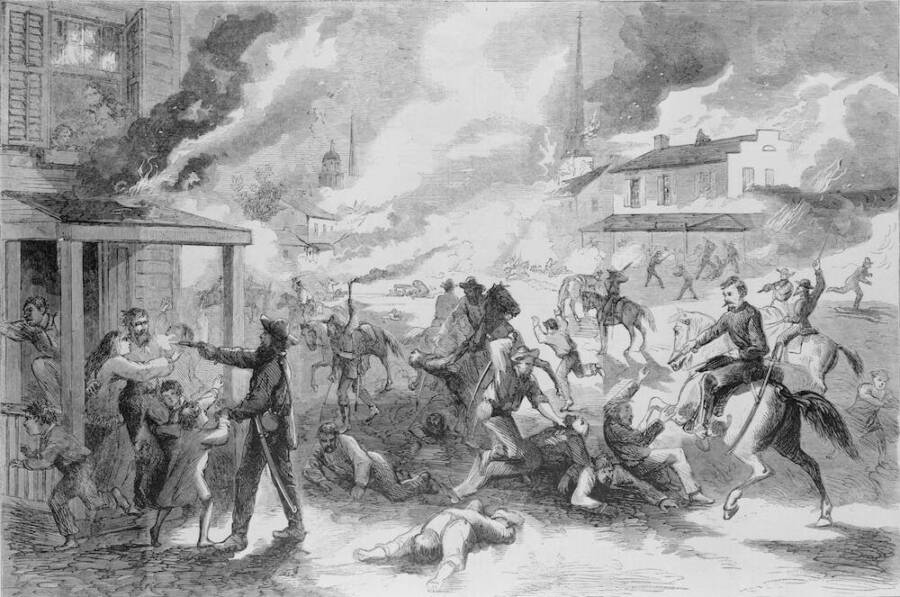
Library of CongressThe raid on Lawrence, Kansas, led by pro-slavery forces impelled Brown’s attack on Pottawatomie Creek and the “Pottawatomie Massacre.”
“God is my judge,” he declared.
He and his sons continued to battle with pro-slavery forces across Missouri, winning a victory in Palmyra, and suffering a loss in Osawatomie. Along the way, Brown also lost one of his sons to the violence.
But by the time he left Kansas in 1857 or 1858, John Brown was determined to end slavery for good. Before long, he’d launch his raid on Harpers Ferry, which he hoped would foment a slave rebellion in the heart of the South.
Inside The Bloody Raid On Harpers Ferry
Following his foray into Kansas, John Brown worked with many prominent abolitionists, including Harriet Tubman and Frederick Douglass. Both Tubman and Douglass greatly admired Brown. But when he started to solicit support for his plan to overthrow slavery, neither wanted to be involved.
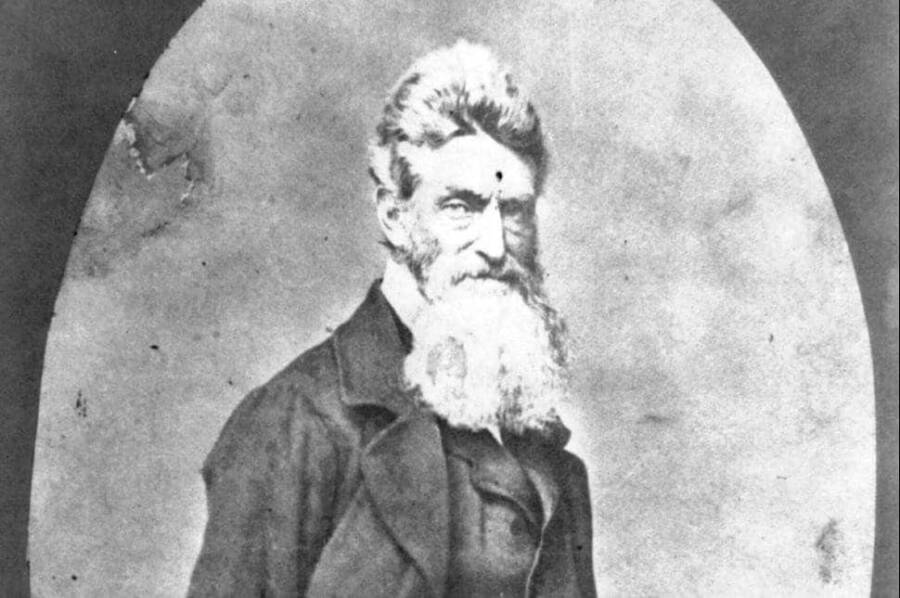
Library of CongressJohn Brown circa 1859, the year of his raid on Harpers Ferry.
According to Smithsonian Magazine, Tubman may have worried that Brown’s plan could endanger the Underground Railroad. Douglass, on the other hand, was certain that Brown was “going into a perfect steel trap.” Instead, Brown received funds from a group of abolitionists known only as the “Secret Six.”
A few months before he put his plan into action, Brown penned a stirring document outlining his beliefs about slavery. Written in July 1859, and entitled “A Declaration of Liberty by the Representatives of the Slave Population of the United States of America,” Brown declared that people had the “right” to “resist and change” their government.
Then, on Oct. 16, 1859, John Brown prepared his raid on Harpers Ferry, Virginia, where a federal arsenal was located 60 miles from Washington D.C. Some 18,000 enslaved people lived nearby, and Brown was confident that they would take up arms alongside him once they heard of the raid.
That night, Brown led his band of 21 Black and white men on a successful raid on Harpers Ferry. He declared that he sought to free “all the negroes in this state” and that resistance would be met with fire and bloodshed.
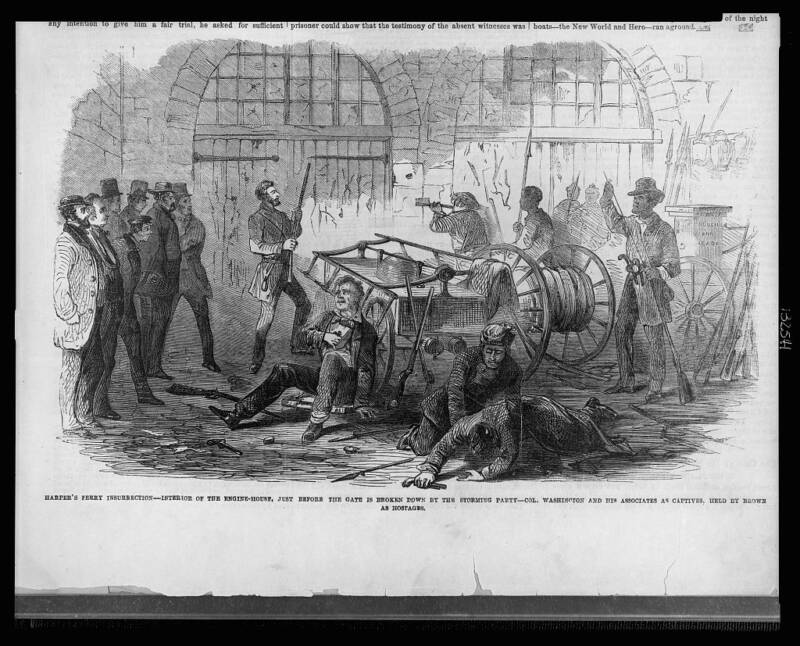
Library of CongressJohn Brown and his followers from their position in the fire engine house during the raid on Harpers Ferry.
“We are Abolitionists from the North, come to take and release your slaves; our organization is large, and must succeed,” John Brown proclaimed. “Slaveholders I regard as robbers and murderers; and I have sworn to abolish slavery and liberate my fellow men.”
But the thousands of enslaved people whom Brown had predicted would “swarm” to him like “bees” did not come. And as word spread about the raid on Harpers Ferry, local militia, quickly followed by a company of U.S. Marines, marched upon the arsenal. The Marines were led by none other than Col. Robert E. Lee, who would soon command the Confederate Army.
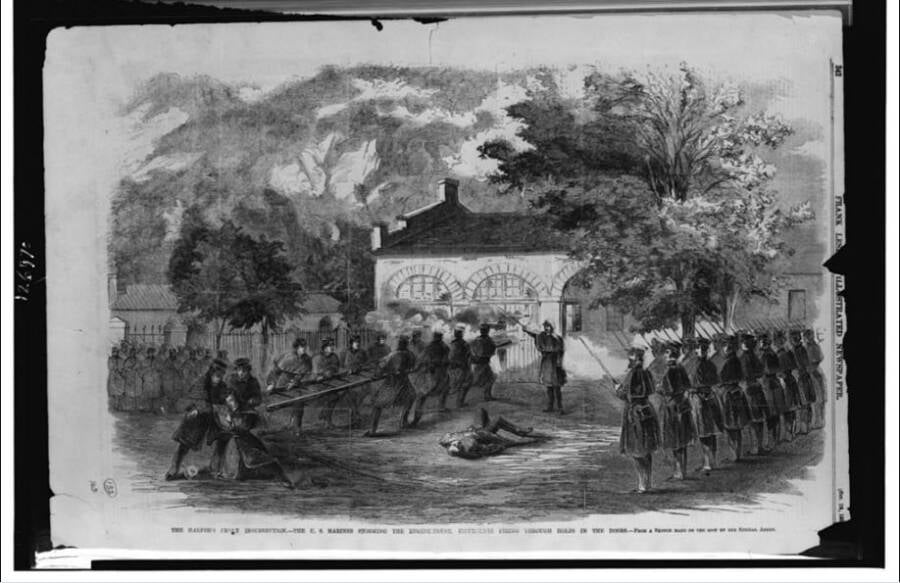
Leslie’s Illustrated Newspaper/Library of CongressAn 1859 lithograph of the Marines firing on John Brown and his men at Harpers Ferry.
Lee demanded that Brown surrender; Brown refused. And on Oct. 18, less than 36 hours after Brown had first launched the Harpers Ferry raid, Lee and his forces managed to retake the arsenal. Brown was badly beaten; most of his remaining men were taken prisoner or killed.
As Robert E. Lee later recalled, “The whole thing was over in a few minutes.” But John Brown’s raid on Harpers Ferry would have long-lasting implications.
The Legacy Of The Raid On Harpers Ferry
On Nov. 2, 1859, John Brown was found guilty of treason, murder, and “conspiring with Negroes to produce insurrection” and sentenced to death. According to Gilder Lerman, he stated during his trial that “never did intend murder, or treason, or the destruction of property, or to excite or incite Slaves to rebellion, or to make insurrection,” but wanted only to “free Slaves.”
However, Brown stuck by his actions, adding: “Now, if it is deemed necessary that I should forfeit my life for the furtherance of the ends of justice, and mingle my blood further with the blood of my children and with the blood of millions in this slave country whose rights are disregarded by wicked, cruel, and unjust enactments, I submit; so let it be done!”
He was hanged on December 2, 1859. Before his death, he handed one of his guards a note which read: “I John Brown am now quite certain that the crimes of this guilty land: will never be purged away; but with blood.”

Metropolitan Museum of Art“The Last Moments of John Brown” by painter Thomas Hovenden, circa 1882 – 1884.
Indeed, Americans in the North and South reacted in dramatically different ways to the raid on Harpers Ferry. John Brown’s actions had deepened divisions between pro- and anti-slavery factions, and the two sides argued over whether Brown had been akin to a terrorist.
Southern newspapers stressed the importance of slavery and warned that the raid on Harpers Ferry could lead to copycat attacks. “We regard every man in our midst an enemy to the institutions of the South who does not boldly declare that he believes African slavery to be a social, moral, and political blessing,” declared the Atlanta Confederacy.
On the other hand, Northerners largely viewed Brown as a noble martyr. “Let the day of his execution… be the occasion of such a public moral demonstration against the bloody and merciless slave system as the land has never witnessed,” thundered the abolitionist newspaper The Liberator.
But it was the Richmond Enquirer who spoke the most prophetically, writing: “The Harpers Ferry invasion has advanced the cause of disunion more than any other event that has happened since the formation of [our] government.”
A year and a half later, in April 1861, the Civil War would begin.
After reading about the Harpers’ Ferry raid, learn about four other slave rebellions that took place in the decades preceding the Civil War. Or, go inside the surprisingly complicated question of when the Civil War ended.





